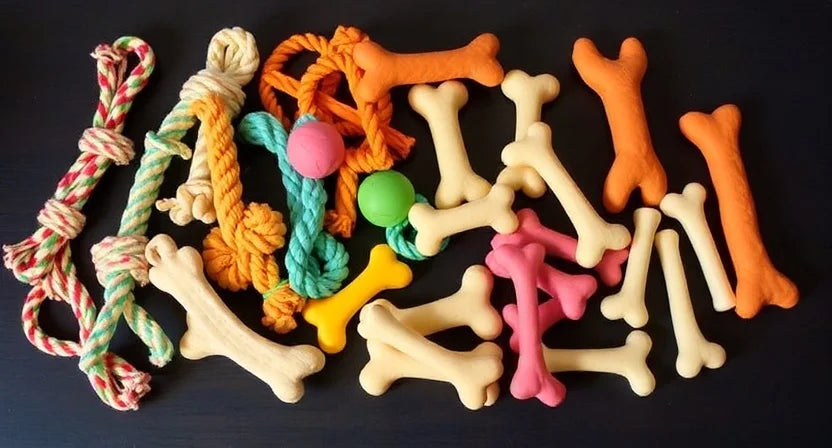Introduction
Chewing is a natural behavior for dogs and, to some extent, for cats. It helps them explore their environment, relieve stress, and keep their teeth clean. As pet parents, we often struggle with balancing this instinctive need with protecting our furniture and belongings. That’s where chew toys for health come in. These toys are specifically designed not only to entertain pets but also to provide dental benefits and reduce anxiety-related behaviors.
In this comprehensive guide, we’ll dive into why chew toys are essential, how they contribute to dental health and emotional well-being, the different types available, and tips to choose the right ones for your furry companion.
Why Chew Toys Are Important
Chew toys are more than just playthings. They fulfill critical needs for both dogs and cats:
-
Mental stimulation
-
Oral health maintenance
-
Stress and anxiety management
-
Energy release
-
Preventing destructive chewing behaviors
By incorporating chew toys into your pet’s daily routine, you can support their long-term health and happiness.

Chew Toys for Dental Health
Dental problems are among the most common health issues in pets. Plaque, tartar, and gum disease can cause pain, bad breath, and even serious systemic health problems if left untreated. Dental chew toys provide a natural way to help combat these issues.
How They Work
-
Scrubbing Action: The textured surfaces of chew toys gently scrape plaque and tartar off teeth.
-
Stimulating Saliva: Chewing increases saliva production, which helps wash away bacteria.
-
Massaging Gums: Soft rubber or rope toys stimulate gum tissue, improving circulation.
Benefits
-
Fresher breath
-
Reduced risk of periodontal disease
-
Stronger teeth and gums
-
Lower vet bills from professional cleanings

Chew Toys for Anxiety Relief
Just like humans, pets can experience anxiety from separation, loud noises, or changes in routine. Chewing is a natural coping mechanism that helps them self-soothe.
Anxiety-Reducing Features
-
Durability: Tough toys withstand long chewing sessions, providing distraction.
-
Engagement: Toys with hidden treats keep pets occupied for hours.
-
Calming Effect: The repetitive motion of chewing releases endorphins, which promote relaxation.
Situations Where They Help
-
When left alone for long hours
-
During thunderstorms or fireworks
-
When adjusting to new homes or environments
-
For pets with high energy or nervous tendencies

Types of Chew Toys
1. Rubber Chew Toys
Durable and often designed with ridges for dental cleaning.
2. Rope Toys
Great for interactive play and flossing teeth.
3. Edible Chews
Dental sticks and natural chews that provide both nutrition and oral health support.
4. Interactive Chew Toys
Toys that dispense treats or require problem-solving keep pets mentally stimulated.
5. Cat-Specific Chews
Silvervine sticks, dental chews, or fabric toys infused with catnip.

How to Choose the Right Chew Toy
-
Consider size and breed: Larger dogs need tougher toys, while smaller pets need softer options.
-
Material safety: Look for BPA-free, non-toxic materials.
-
Durability: Aggressive chewers require heavy-duty rubber or nylon.
-
Supervision: Always monitor your pet with new toys until you’re sure they’re safe.
-
Variety: Rotate toys to prevent boredom and maximize benefits.
Challenges and Things to Watch Out For
-
Over-chewing: Some pets may chew excessively and risk damaging teeth.
-
Inappropriate size: Toys that are too small can be choking hazards.
-
Worn-down toys: Replace damaged toys to prevent ingestion of small parts.
By staying aware of these challenges, you can maximize the benefits of chew toys while minimizing risks.
FAQs About Chew Toys for Health
1. Are chew toys safe for puppies and kittens?
Yes, but choose toys made specifically for young pets with softer teeth.
2. Can chew toys replace brushing?
No. Chew toys support dental health but should complement regular brushing and vet checkups.
3. Do cats really need chew toys?
Yes, especially indoor cats. Chew toys help with dental care and prevent boredom.
4. How often should I replace chew toys?
Inspect toys weekly. Replace them if they show signs of wear or breakage.
5. Can chew toys help with teething puppies?
Absolutely. Chewing soothes sore gums and helps puppies transition from baby to adult teeth.
6. Are edible chews better than rubber toys?
Both have benefits. Edible chews can improve nutrition, while rubber toys last longer.
7. What’s the best chew toy for an anxious dog?
Durable rubber toys with treat compartments work well for anxiety relief.
8. How do I know if my pet likes their chew toy?
Signs include frequent chewing, carrying the toy around, and reduced destructive behaviors.
Conclusion
Chew toys for health are essential tools for improving both dental hygiene and emotional well-being in pets. By incorporating safe, durable, and engaging toys into your pet’s daily routine, you not only promote oral health but also help them manage stress and anxiety. With the wide range of options available today, every pet owner can find chew toys suited to their pet’s needs and personality.
Investing in the right chew toys means investing in your pet’s overall wellness, ensuring they live a happier, healthier, and more fulfilling life.







